We'll get to the "megaphone" in a bit. Relax.
First - as you'll recall - we fell asleep on our last night in the preserve, under the stars, and in the shadow of the Granite Mountains.
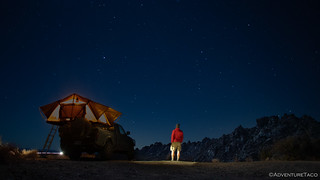
We were, however, reasonably near a paved road, and traffic continued through the night - rendering earplugs necessary for a peaceful sleep. And so, when my alarm sounded just a bit after 5:45am in the morning, I was happy to pull those puppies out of my ears and grab the camera - hoping that our little spot on the top of a rise would afford nearly 360° views of the coming sun.
Except that clouds were stacking up on the horizon. 

Still, I wandered away from the truck knowing that - as always - winds can be unpredictable. A cloudy sky now might be clear in just a few minutes. Or a break in the clouds might afford the most brilliant splash of color to streak across the sky. These were things I was ready for, as the world around me was illuminated - the Granite Mountains glowing tall for all of about 20 seconds behind the Tacoma.

This being our last morning - and with only about half-a-day worth of itinerary before we started the long trek home - we moved slowly, @mrs.turbodb only coming out of the tent as the sun was hitting it at nearly 8:00am, a full hour after our usual departure time.

Breakfast was - as always - a quick affair, and we were on the road in under an hour - the tent packed away dry and ready for whatever our next trip might be. We were headed west - toward what turned out to be the Mojave Trails National Monument -but what we knew as the I-40 exit to Ludlow.
Settled in the 1870s, it was named after William Ludlow of Southern Pacific Railroads - though it had no affliation with that particular line. Rather, it was initially a water stop for the Atlantic and Pacific Railroad, and later the southern railhead for the Tonopah and Tidewater Railroad, operated by the Pacific Coast Borax Company, hauling borax and other mining products from Death Valley and Beatty, Nevada to the longer distance Santa Fe Railway lines.
Today, it's not much more than a refueling and rest stop on the side of the highway - a couple gas stations and places to eat comprising the majority of the "town." Of those, only the Ludlow Cafe - though not original - was out of the ordinary, though clearly catering to the Route 66 historians who passed this way.
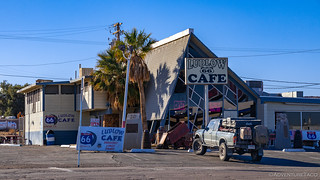

Naturally, Ludlow itself was not the reason we'd chosen this exit. We were headed north - on Crucero Road - into the desert. Predictably, perhaps. 
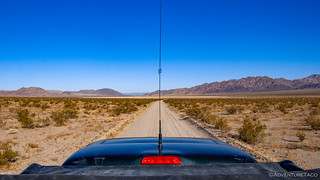
Unsure if the route I'd scouted would be passable, but encouraged by the state of the road, we continued due north towards the playa of Broadwell Lake. Reports on this playa are varied - some finding it an easy drive and others encountering deep sticky mud, similar I suppose to the Soda Lake bed 50 miles north near Baker, CA. Lucky for us, the lack of recent precipitation meant a fast trip across the smooth bed - and a dramatic increase in the odds that we'd make it to the Mojave Megaphone.


Past the playa, the well-marked road - apparently part of the Mojave Trails National Monument - undulated across alluvial fans, dipped in and out of washes, and bounced along next to the old raised rail grade of the Tonopah and Tidewater Railroad - much of the old timber slowly fading into history.

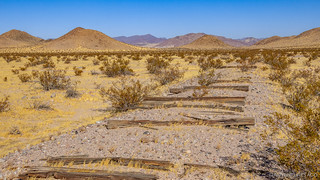
Along this lonely stretch of road we found the most peculiar cabins. Three properties in all, they were reasonably well-kept and likely some sort of getaway or retreat for their owners. Curiosity got the better of us - as it often seems is the case - and we respectfully walked one of the properties just to see what it was all about.

"Al's Summer Place."

The elusive Mojave Jackalope.

Directions home.
We could see why Al kept this place - on a day like today, the temps in the high 60s°F, the sun and breeze making for a pleasant afternoon - it was just about perfect. With fire pits and gathering areas scattered around, it would have been a wonderful place to hang out with friends, discussing which direction to head off in next, when the time was right.
For us, that direction continued to be north. Now only a few miles to our destination - one not on Al's list of signs - the Mojave Megaphone.

Perched atop a pile of granite, the "Mojave Megaphone" as it has come to be called, has been a mystery to many over the years. Theories abound as to its origin - perhaps related to the Tidewater and Tonopah Rail, or to military exercises conducted in the nearby valley; perhaps a test funnel for early rocket research or part of a siren to warn workers of impending danger. Maybe, it is a drum.
It is - for certain - a strange shape to see out here in the middle of nowhere; but, it is none of those things.


Leaping from rock to rock, we picked our way up, @mrs.turbodb just as curious about the device as those on the internet who speculated about this contraption.


Here's the real story:
A little over eight feet long, the construction of the device - along with design papers found in a nearby desert cabin - is what gives away its origin. Constructed of two, essentially mirrored halves, bolted together along a seam in the middle, the cones are simply 32 pieces of 3/32" steel, roughly welded together.
The 3/32" steel is too thin for any industrial application, but reduces weight of the overall device, which is welded only roughly along the outer seams - with plenty of gaps along the lengths of the welds. The inside of each seam is completely unfinished.
The halves enable the device to be easily carried by two people, each half weighing only 143 lbs, eventually bolted together in their current location.
The bars within the cones - suspected to be sights for some sort of aiming - are nothing of the sort. Not only are they constructed of dissimilar materials - rebar, and a random segment of pipe - but they are much too rough, and not at all centered in the opening. Not only would a sight rest on top of the device - similar to a gun sight, but the device itself would - obviously - be adjustable as the sights were used to aim it. Without that adjustability, sights are unnecessary.
The "Mojave Megaphone" is - whether folks like it or not - one of the original metal monoliths, nothing more. It need not be - the ingenuity of its design enabling it to survive when others have not.
January 2024 Update
I have no idea if this is even a real newspaper article - I couldn't find any reference to it or its author on the internet - but this article suggests that the megaphone may have initially been a drum, and I do know of Bill Mann.
Mojave Desert Holds Many Mysteries

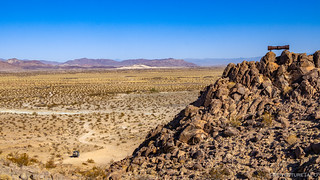
Having thoroughly enjoyed poking around the site for half-an-hour or so, we were both getting hungry and decided that another lunch-and-hunt-for-petroglyphs for the second day in a row would be just as enjoyable as the first. So, it was back in the truck and to the general vicinity of the glyphs.

There, @mrs.turbodb began sandwich prep while I resumed my role as "searcher." Today however, unlike my previous failure, I found the petroglyphs quickly! Scattered across half a dozen large boulders, they were not the most amazing we'd seen, but that mattered little - the thrill of finding them, always a reward in itself!

You can clearly see here, a man designing the "sighting" system for the Mojave Megaphone.

Determination of the optimal size for the megaphone components.

Fat caterpillar, mastermind behind the Mojave Megaphone.
Our bellies full and the time a little after noon, it was finally time for us to make our exit. We'd decided that our quickest route back to the highway would be through Afton Canyon - a path we'd travelled during our first trip on the Mojave Road, the 36" deep water raising our adrenaline levels higher than they've ever been.
This time, however, would be different! 
As we turned west and pressed the skinny pedal, a trail of dust was visible in the distance. Obviously travelling slower than we were, I joked to @mrs.turbodb that I hoped the driver of the Jeep would notice us in their mirrors and pull over so we could continue on at our higher rate of speed.
But, as we pulled along side, it was time to eat my sarcasm. Who needed a well-built truck when you could do the road in a... minivan? 

In my defense, this is a rail worker, driving on the grade.
We both got a good laugh out of the bad-ass minivan, his route along the tracks allowing us - on a sand track next to the grade - to fly by without so much as slowing down. Soon, we found ourselves at the mouth of Afton Canyon - the iconic Union Pacific trestle spanning the wide wash.
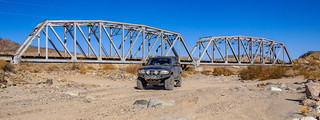
Despite the water crossing at its western mouth, Afton Canyon is one of my favorite places around the preserve. The six mile drive up the wash - the Mojave River squeezing between striking badlands - is breathtaking. Made of soft sedimentary rocks, the canyon walls have been deeply chiseled into amazingly colorful displays of spires and gullies. This was easily the most spectacular scenery along the entire Mojave Road when we'd travelled it two years earlier, and I was itching to see it all again!


The canyon delighted us. I made a mental note to return again - if possible, for several days - to explore the many side canyons that worked their way north and south from the main wash.
At one point, @mrs.turbodb suggested we investigate one especially enticing depression carved into the walls. I was initially reluctant - knowing we had a 12+ hour drive before reaching our stopping point for the night near Castle Crags State Park - but dang it if curiosity didn't once again get the better of me and I turned around.
Thank goodness I did.

@mrs.turbodb named this "Happy wife, happy life falls." 


And with that, we made our final push up the canyon. Along the way, we passed a built 2nd gen Tacoma, "ACETACO" who was just starting out on a week long journey along the Mojave Road - or more likely half of that, with a few days to spare! He was out of his truck as we drove under the trestle, having spotted a bighorn sheep as he'd started down the wash.

Greetings and safe travels exchanged, the only thing left for us to do was make our way across the infamous crossing. As we'd done the last time we were here, I parked just before the entrance to scout the situation.

Sure enough, the intel I'd gathered a few days prior to departure was correct - this time through the crossing was going to be much less stressful - water wise, at least - than the last. You see, Union Pacific had been working on a couple of the trestles, and to make access easier, they'd filled in the crossing with 6-10" size stone, up to a level approximately 3" below the surface!

There was no better way to describe it than "fun."

And so - as we neared our onramp to I-15 - came the end of our week of low tire pressures. In an effort to avoid California fuel prices as long as possible, I transferred everything in the 5-gallon Scepter jerry cans to the tank while @mrs.turbodb inflated the tires to a mpg-friendly 40psi. And then we headed north.
The next morning - and with only a few few hours sleep - we set out again, the brilliant blue sky highlighting Castle Crags as we said goodbye to California for the last time this year.




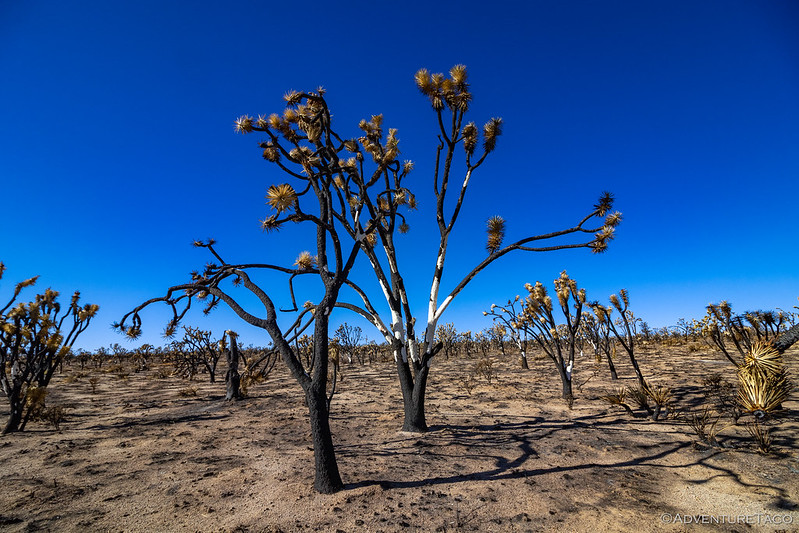


Thank you for this beautiful adventure-share. You obviously love our Mojave. It has a unique beauty that is, for some, an acquired taste. I love your narrative that keeps it real. This post gave me inexplicable joy. Blessings to you both.
So glad you enjoyed it Ann! The Mojave has become a favorite retreat for me, for sure, over the last several years. I now look forward to the winter months, when I can spend much more time there, exploring the wide open spaces and immense amounts of history and mystery. ?
Thank you for a wonderful journey!
I'll be heading out to enjoy the Mojave Road at the end of March. I'm so looking forward to seeing the beauty your pictures show...with my own eyes!
Enjoy life and be safe!
David
Awesome - glad you enjoyed the story David, and even happier to hear you're going to experience the Mojave yourself! Stay safe and have FUN! ?
This looks to be a smoke stack from a steam locomotive of the time. That's why the Venturi shape.
If you look on the Internet for these stacks, you can see what I'm talking about. It also makes sense that this may have been something left behind of the old railroad operation.
https://www.google.com/search?q=steam+engine+stacks
Hey Greg, I know the stacks you're talking about, and this isn't one of those ?. Probably hard to really get a sense of scale, but this is much bigger. Also - and more importantly - the construction of it is much flimsier, as in barely held together. Lastly, the materials used are significantly newer than anything made by the old railroads. The Megaphone is art, desert lore, and totally worth going to check out in person!
We love the Mojave which is why we live here although there are many places we can't explore so always grateful for your adventures and photos. I do hope to (finally) do some hiking in the Devil's Punchbowl when it warms up a bit.
Megaphone
I searched this newspaper archive and the megaphone article comes as a black and white. If you want to pay for the site, you’ll get a better copy. It appears the Mojave megaphone article is real.
Huh, when I search that site for "Megaphone" on that site it just comes back with the number of search results (but no images). I did search a different site and got a hit for the article, which I've linked in the archive. Nice to know that the article is real! I doubt, however, that it will put to rest any of the speculation around the purpose of the Megaphone.